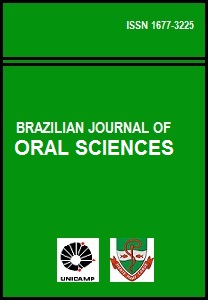Abstract
Tooth transposition is an anomaly in the position of teeth where two teeth of the same maxillary quadrant change their position in the dental arch. There are different types of transposition, classified according to the involved teeth. The review of the etiology of tooth transposition aims at identifying the factors related to its occurrence, and the purpose of this study is to report a case of cleft lip. Studies indicate higher prevalence of upper Canine – First Premolar transposition compared to other types of transposition, as well as a higher prevalence among females and of its unilateral occurrence. Mx.C.P1 is also related to anomalies in tooth number, especially with the agenesis of the lateral incisor. The clinical case of cleft lip and upper Canine – First premolar transposition presented in this study enables the discussion of aspects regarding the etiology of tooth transposition and of predisposing factors. Both the Mx.C.P1 transposition and cleft lip and palate are related to genetic factors and present a multifactorial inheritance pattern. The importance of prevention and early detection of tooth transposition is reaffirmed, aiming at minimizing the disturbances caused by tooth transposition. Further research on the prevalence of tooth transposition in populations with cleft lip and palate would yield a better insight about the simultaneous occurrence of these dental and oral anomalies. The therapeutic procedures for functional and cosmetic rehabilitation of the reported patient are described.References
Shapira Y, Kuftinec MM. Maxillary tooth transpositions: Characteristic features and accompanying dental anomalies. Am J Orthod Dentofacial Orthop. 2001; 119: 127-34.
Peck S, Peck L. Classification of maxillary tooth transpositions. Am J Orthod Dentofacial Orthop. 1995; 107: 505-17.
Laptook T, Silling G. Canine transposition – approaches to treatment. J Am Dent Assoc. 1983; 107: 746-8.
Peretz B, Arad A. Bilateral transposition of maxillary canines and first premolars: case report. Quintessence Int. 1992; 23: 345-8.
Shapira Y, Kuftinec MM. Tooth transpositions – a review of the literature and treatment considerations. Angle Orthod. 1989; 59: 271-6.
Peck L, Peck S, Attia Y. Maxillary canine-first premolar transposition, associated dental anomalies and genetic basis. Angle Orthod. 1993; 63: 99-109.
Chattopadhyay A, Srinivas K. Transposition of teeth and genetic etiology. Angle Orthod. 1996; 66: 147-52.
Peck S, Peck L, Kataja M. Site-specificity of tooth agenesis in subjects with maxillary canine malpositions. Angle Orthod. 1996; 66: 473-6.
Ruprecht A, Batniji S, El-Neweihi E. The incidence of transposition of teeth in dental patients. J Pedod. 1985; 9: 244-9.
Tukkahraman H, Sayin MO, Yilmaz HH. Maxillary canine transposition to incisor site: a rare condition. Angle Orthod. 2005; 75: 284-7.
Weeks EC, Power SM. The presentation and management of transposed teeth. Br Dent J. 1996; 181: 421-4.
Plunket DJ, Dysart PS, Kardos TB, Herbison GP. A study of transposed canines in a sample of orthodontic patients. Br J Orthod. 1998; 25: 203-8.
Budai M, Ficzere I, Gabris K, Tarjan I. Frequency of transposition and its treatment at the Department of Orthodontics of Semmelweis University in the last five years. Fogorv SZ 2003; 96: 21-4.
Yilmaz HH, Tukkahraman H, Sayin MO. Prevalence of tooth transpositions and associated dental anomalies in Turkish population. Dentomaxillofac Radiol. 2005; 34: 32-5.
Segura JJ, Hattab F, Rios V. Maxillary canine transpositions in two brothers and one sister: associated dental anomalies and genetic basis. ASDC J Dent Child. 2002; 69: 54-8.
Peck S, Peck L, Kataja M. Concomitant occurrence of canine malposition and tooth agenesis: Evidence of orofacial genetic fields. Am J Othod Dentofacial Orthop. 2002; 122: 657-60.
Quezada MGC, Hoeksma JB, Velde JP, Prahl-Andersen B, Kuijpers-Jagtman AM. Dental anomalies in patients with familial and sporadic cleft lip and palate. J Biol Buc. 1988; 16: 185-90.
Shapira Y, Lubit E, Kuftined MM, Stom D. Hypodontia in children with various types of clefts. Angle Orthod. 2000; 70: 16-21.
Pembertom TJ, Das P, Pragna IP. Hypodontia: genetics and future perspectives. Braz J Oral Sci. 2005; 4: 695-706.
Damante JH, de Souza Freitas JA, Moraes N. Anomalias dentárias de número na área da fenda em portadores de malformações congênitas lábio palatais. Estomat Cult. 1973; 7: 88-97.
Slayton RL, Williams L, Murray JC, Wheeler JJ, Lidral AC, Nishimura CJ. Genetic association studies of cleft lip and/or palate with hypodontia outside the cleft region. Cleft Palate Craniofac J. 2003; 40: 274-9.
Vichi M, Franchi L. Eruption anomalies of the maxillary permanent cuspids in children with cleft lip and/or palate. J Clin Pediatr Dent. 1996; 20: 149.
Ranta R. Comparison of tooth formation in noncleft and cleft-affected children with and without hypodontia. ASDC J Dent Child. 1982; 49: 197-9.
Ranta R. A review of tooth formation in children with cleft lip/palate. Am J Orthod Dentofacial Orthop. 1986; 90: 11-8.
Solis A, Figueroa AA, Cohen M, Polley JW, Evans CA. Maxillary dental development in complete unilateral alveolar clefts. Cleft Palate Craniofac J. 1998; 35: 320-8.
Shapira Y, Lubit E, Kuftinec MM, Stom D. Congenitally missing premolars in cleft lip and cleft palate children. Am J Orthod Dentofacial Orthop. 1999; 115: 396-400.
Ribeiro LL, Neves LT, Costa B, Gomide MR. Dental development of permanent lateral incisor in complete unilateral cleft lip and palate. Cleft Palate Craniofac J. 2002; 39: 193-6.
Heidbüchel KLWM, Kuijpers-Jagtman AM, Ophof R, Hooft RJM. Dental maturity in children with a complete bilateral cleft lip and palate. Cleft Palate Craniofac J. 2002; 39: 509-12.
Mattos BSC, André M, Saboia ACL, Alvarenga RF. Assimetria de incisivos centrais superiores permanentes em indivíduos portadores de fissura lábio palatina unilateral. RPG Rev PosGrad. 1997; 4: 141-5.
Bocchieri A, Braga G. Correction of a bilateral maxillary canine-first premolar transposition in the late mixed dentition. Am J Orthod Dentofacial Orthop. 2002; 121: 120-8.
Sato K, Yokozeki M, TakagoT, Moriyama K. An orthodontic case of transposition of the upper right canine and first premolar. Angle Orthodontist 2002; 72: 275-8.
Shapira Y,Kuftinec MM. Intrabony migration of impacted teeth. Angle Orthod. 2003; 73: 738-43.
The Brazilian Journal of Oral Sciences uses the Creative Commons license (CC), thus preserving the integrity of the articles in an open access environment.

